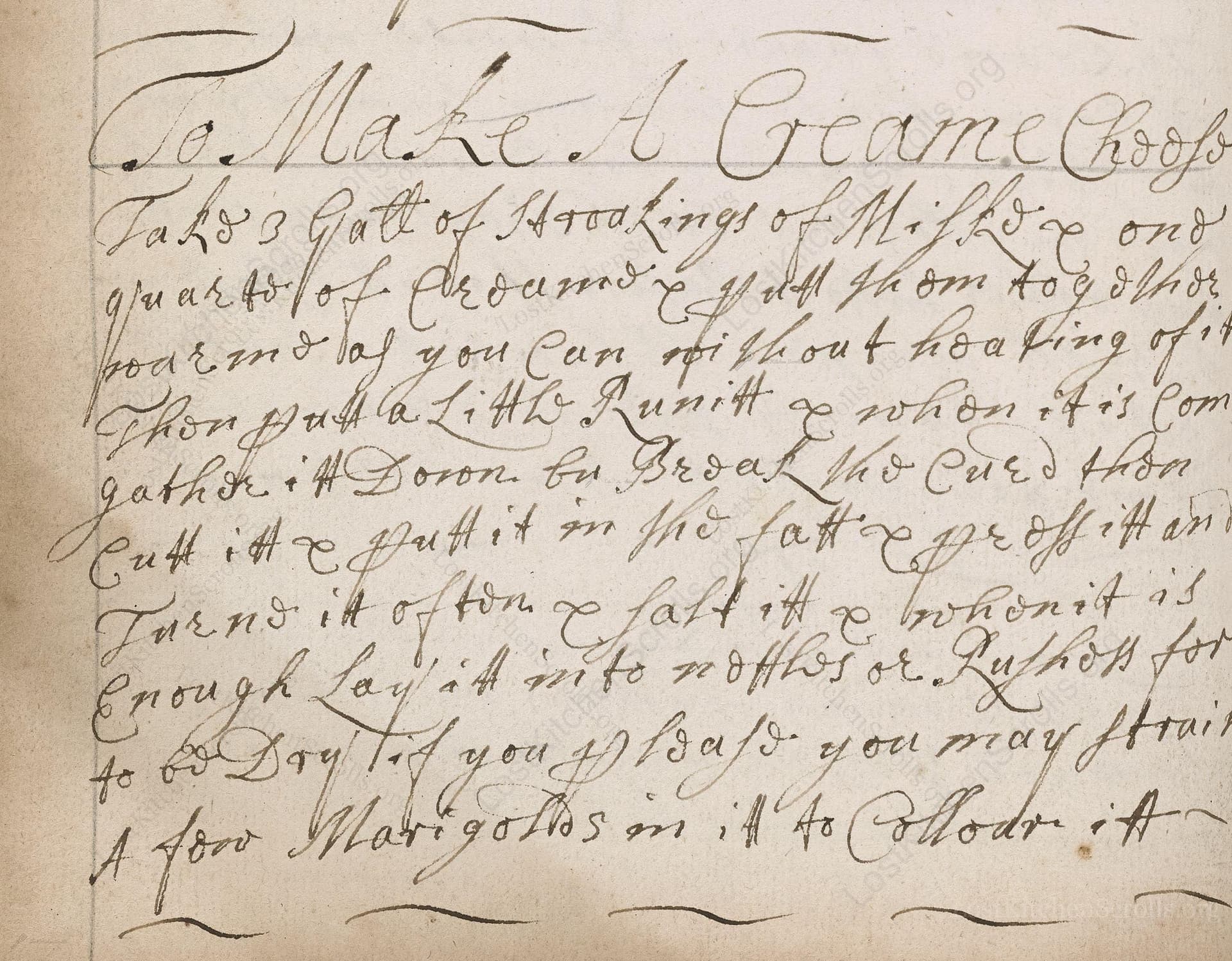To Make A Creame Choofe
From the treasured pages of Cookbook of Ann Smith, Reading
Written by Ann Smith

To Make A Creame Choofe
"Take 3 Gatt of Strakings of Milk & one quater of Saltt. Strain it & pull them together as much as you can without Heating of itt. Then put a Litle Runitt & when it is Come gather it to gether to Break the Curd then Cutt it & put it in the Fatt & press it till it turns it offton & fast it & when it is Enough Lay it into Glasses or Cups for to Dry it & so serve it. you may strain a few Marygolds in it to Collor it."
Note on the Original Text
This recipe, written in the late 17th century, captures the fluid and conversational tone of domestic manuscript instructions—with little standardization for spelling or measurements. Terms like 'choofe' (probably a variant of 'chouffe' or 'cheese') and 'runitt' (rennet) reflect both contemporary pronunciation and lack of spelling norms. Instructions rarely detail temperatures or times, assuming a cook’s experience and intimate familiarity with their tools and ingredients—hence the reliance on visual and tactile cues such as 'when it is Come.'

Title
Cookbook of Ann Smith, Reading (1698)
You can also click the book image above to peruse the original tome
Writer
Ann Smith
Era
1698
Publisher
Unknown
Background
Step into the sumptuous kitchens of 17th-century England with Ann Smith’s culinary treasury, where traditional recipes and time-honored techniques invite you to savor the flavors of history. Each page promises a feast of inspiration and a glimpse into the artful dining of a bygone era.
Kindly made available by
Folger Shakespeare Library
This fascinating recipe appears in Ann Smith’s manuscript dated 1698, an era when home dairying and cheese-making were routine parts of English household management. 'Creame Choofe' sits delightfully between a soft cheese and a rich, pressed curd—a delicate treat for the early modern English table, often enjoyed fresh. The mention of marigolds reflects a tradition of floral coloring in cheeses, both for festive occasions and household pride. This recipe would have been prepared at a time before pasteurization or standardized rennet, using milk straight from the household cow or local dairy.

Back then, robust wooden or earthenware tubs held the milk. A coarse cloth, like muslin or fine linen, was used to strain and gather the curds. A 'fatt'—a small hoop or mold—helped shape and gently press the cheese. Wooden spoons or ladles aided in moving the curds, and glasses or cups served both as molds and as vessels for final presentation. The pressing likely relied on simple kitchen weights or by manually turning and adjusting the curd.
Prep Time
2 hrs 30 mins
Cook Time
0 mins
Servings
8
We've done our best to adapt this historical recipe for modern kitchens, but some details may still need refinement. We warmly welcome feedback from fellow cooks and culinary historians — your insights support the entire community!
Ingredients
- 3 imperial gallons whole raw milk (or best quality whole milk available)
- 1/4 ounce fine sea salt
- Rennet (following supplier's dosage, usually 1/4-3/4 tsp per imperial gallon milk)
- Optional: a handful of edible marigold (calendula) petals or substitute with saffron strands for color
Instructions
- To make this historic 'Creame Choofe,' begin by taking roughly 3 imperial gallons (6.8 liters) of whole, unpasteurized milk.
- Let the milk stand, then collect the cream-rich top (the 'strakings').
- Add a generous pinch—about 1/4 ounce (0.25 oz or 0.25 oz avoirdupois) of sea salt, stirring thoroughly, but without warming the mix.
- Strain the mixture.
- Add a small amount (check your supplier's recommendation, usually a few drops per pint or tsp per gallon) of liquid animal rennet to set the curd.
- Let the mixture rest until it has 'come' or set.
- Gather the curd gently, break it up slightly, and cut it into chunks.
- Spoon or pour the curds into a cheese mold (a modern colander or small mold lined with muslin works too), press gently, turning frequently, until most whey drains off.
- Once firm enough, transfer into cups or small glasses to finish drying before serving.
- For color, strain a handful of calendula (marigold) petals into the milk during early steps.
Estimated Calories
320 per serving
Cooking Estimates
It takes about 30 minutes to prepare the milk, gather the cream, and mix in the salt and rennet. Setting the curd and draining the whey takes about 2 hours. Most of that time is waiting, not active work. The recipe makes about 8 servings, each with about 320 calories.
As noted above, we have made our best effort to translate and adapt this historical recipe for modern kitchens, taking into account ingredients nowadays, cooking techniques, measurements, and so on. However, historical recipes often contain assumptions that require interpretation.
We'd love for anyone to help improve these adaptations. Community contributions are highly welcome. If you have suggestions, corrections, or cooking tips based on your experience with this recipe, please share them below.
Join the Discussion
Rate This Recipe
Dietary Preference
Main Ingredients
Culinary Technique
Occasions

Den Bockfisch In Einer Fleisch Suppen Zu Kochen
This recipe hails from a German manuscript cookbook compiled in 1696, a time whe...

Die Grieß Nudlen Zumachen
This recipe comes from a rather mysterious manuscript cookbook, penned anonymous...

Ein Boudain
This recipe comes from an anonymous German-language manuscript cookbook from 169...

Ein Gesaltzen Citroni
This recipe, dating from 1696, comes from an extensive anonymous German cookbook...
Browse our complete collection of time-honored recipes



